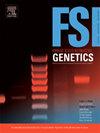TrACES of time: Towards estimating time-of-day of bloodstain deposition by targeted RNA sequencing
IF 3.1
2区 医学
Q2 GENETICS & HEREDITY
引用次数: 0
Abstract
In forensic molecular biology, the main task consists of identifying individuals who contributed to biological traces recovered from (potential) crime scenes. However, to support evidence-based reconstruction of the course of activities having taken place at the scene, contextualising information regarding how and when a biological trace was deposited is oftentimes required. Here we present the development of a forensic molecular biological analysis procedure for the prediction of the time-of-day at which a bloodstain has been deposited by targeted quantification of selected mRNA markers. Time-of-day candidate prediction markers with diurnally rhythmic expression have previously been identified by whole transcriptome sequencing. Here, we build on our previous findings by establishing a targeted cDNA sequencing protocol on an Ion S5 massively parallel sequencing device for the targeted gene expression quantification of 69 time-of-day candidate prediction markers. Based on expression measurements of these markers in 408 blood samples (from 51 individuals deposited at eight time points over a day), we establish and compare different statistical methods to predict time of deposition. The most suitable model employing penalised regression achieved a root mean squared error of 3 h and 44 min with 78 % of predictions being correct within ± 4 h (evaluated by five-fold cross-validation), showing pronounced inter-individual differences. While the prediction accuracies of the method in its current state limit its use in the evaluative stage of a criminal trial, the method may nonetheless provide valuable information in the investigative phase. Our study provides the first prediction model for time-of-day of bloodstain deposition based on targeted RNA sequencing and thus represents an important step towards forensic trace deposition timing. It thereby relevantly contributes to the growing knowledge on Transcriptomic Analyses for the Contextualisation of Evidential Stains (TrACES).
时间的痕迹:通过靶向RNA测序来估计血迹沉积的时间
在法医分子生物学中,主要任务包括识别从(潜在的)犯罪现场恢复的生物痕迹的个人。然而,为了支持在现场发生的活动过程的循证重建,通常需要关于生物痕迹是如何以及何时沉积的背景信息。在这里,我们提出了一种法医分子生物学分析程序的发展,通过有针对性的定量选择mRNA标记物来预测血迹沉积的时间。具有每日节律性表达的时间候选预测标记先前已通过全转录组测序确定。在此,我们基于之前的研究结果,在离子S5大规模平行测序设备上建立了靶向cDNA测序方案,用于69个候选时间预测标记的靶向基因表达定量。基于这些标志物在408份血液样本中的表达测量(来自51个个体,在一天中的八个时间点沉积),我们建立并比较了不同的统计方法来预测沉积时间。采用惩罚回归的最合适模型的均方根误差为3 h和44 min,其中78 %的预测在±4 h内是正确的(通过五倍交叉验证评估),显示出明显的个体间差异。虽然该方法目前的预测准确性限制了其在刑事审判评估阶段的使用,但该方法仍可在调查阶段提供有价值的信息。我们的研究提供了第一个基于靶向RNA测序的血迹沉积时间预测模型,从而代表了法医痕迹沉积时间的重要一步。因此,它相关地有助于对证据污点(痕迹)的背景化转录组学分析的不断增长的知识。
本文章由计算机程序翻译,如有差异,请以英文原文为准。
求助全文
约1分钟内获得全文
求助全文
来源期刊
CiteScore
7.50
自引率
32.30%
发文量
132
审稿时长
11.3 weeks
期刊介绍:
Forensic Science International: Genetics is the premier journal in the field of Forensic Genetics. This branch of Forensic Science can be defined as the application of genetics to human and non-human material (in the sense of a science with the purpose of studying inherited characteristics for the analysis of inter- and intra-specific variations in populations) for the resolution of legal conflicts.
The scope of the journal includes:
Forensic applications of human polymorphism.
Testing of paternity and other family relationships, immigration cases, typing of biological stains and tissues from criminal casework, identification of human remains by DNA testing methodologies.
Description of human polymorphisms of forensic interest, with special interest in DNA polymorphisms.
Autosomal DNA polymorphisms, mini- and microsatellites (or short tandem repeats, STRs), single nucleotide polymorphisms (SNPs), X and Y chromosome polymorphisms, mtDNA polymorphisms, and any other type of DNA variation with potential forensic applications.
Non-human DNA polymorphisms for crime scene investigation.
Population genetics of human polymorphisms of forensic interest.
Population data, especially from DNA polymorphisms of interest for the solution of forensic problems.
DNA typing methodologies and strategies.
Biostatistical methods in forensic genetics.
Evaluation of DNA evidence in forensic problems (such as paternity or immigration cases, criminal casework, identification), classical and new statistical approaches.
Standards in forensic genetics.
Recommendations of regulatory bodies concerning methods, markers, interpretation or strategies or proposals for procedural or technical standards.
Quality control.
Quality control and quality assurance strategies, proficiency testing for DNA typing methodologies.
Criminal DNA databases.
Technical, legal and statistical issues.
General ethical and legal issues related to forensic genetics.

 求助内容:
求助内容: 应助结果提醒方式:
应助结果提醒方式:


